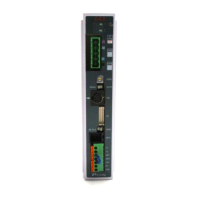53
5.3.2 Details of Each Output Signal
Operating mode status (RMDS)
The internal operating mode of the controller is output based on the AUTO/MANU selector switch on the
controller and the RMOD signal received by the input port. If the selector switch is set to “AUTO” and the
RMOD signal is OFF (AUTO), the controller is in the AUTO (OFF) mode. If the selector switch is set to
“MANU” and/or the RMOD signal is ON (MANU), the controller is in the MANU (ON) mode.
Completed position number (PM1 to PM256)
These signals can be used to check the completed position number when the PEND signal turns ON.
The signals are output as a binary code.
Immediately after the power is input, all of the PM1 to PM256 signals are OFF.
In the standard or teaching type, six bits of PM1 through PM32 are used. In the 256-point type, eight bits
of PM1 through PM128 are used. In the 512-point type, nine bits of PM1 through PM256 are used.
All of these signals are OFF also when the actuator is moving.
As described above, this signal is output only when positioning is completed.
(Note) All of these signals will turn OFF when the servo is turned OFF or an emergency stop is actuated.
They will return to the ON status when the servo is turned ON again, provided that the current
position is inside the in-position range with respect to the target position. If the current position is
outside the range, the signals will remain OFF.
When the power is input, the PEND signal will turn ON. These signals are all OFF, this condition is
the same as one achieved after positioning to position “0” is completed.
Check the position of position 0 after the movement command has completed.
If an alarm is present, the corresponding alarm code (abbreviated form) consisting of four bits from PM1 to
PM8 will be output.
The meanings of these signals vary between the normal condition and the alarm condition, so be careful
not to use them wrongly in the sequence.
Moving (MOVE)
This signal is output while the servo is ON and the actuator is moving (also during home return, push &
hold operation or jogging).
Use the MOVE signal together with the PEND signal to allow the PLC to determine the actuator status.
The MOVE signal will turn OFF after positioning or home return is completed or a judgment is made
during push & hold operation that the load is being contacted.
Position complete (PEND)
This signal indicates that the target position was reached and positioning has completed.
Use the PEND signal together with the MOVE signal to allow the PLC to determine the positioning status.
When the controller becomes ready after the power was input and the servo has turned ON, this signal will
turn ON if the position deviation is within the in-position range.
Then, when a movement command is issued by turning ON the start signal, the PEND signal will turn OFF.
It will turn ON again when the deviation from the target position falls within the in-position range.
Once turned ON, the PEND signal will not turn OFF even when the position deviation subsequently
exceeds the in-position range.
(Note) If the start signal remains ON, the PEND signal will not turn OFF even when the deviation from the
target position falls within the in-position range: it will turn ON when the start signal turns OFF.
Even when the motor is stopped, the PEND signal will remain OFF if the pause signal is input or
the servo is OFF.

